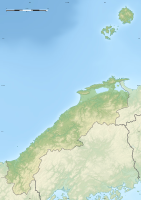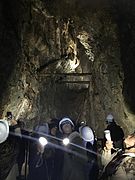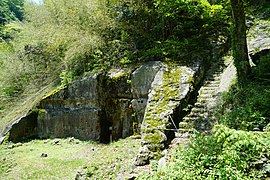Iwami silver mine
| Iwami Ginzan | |||
|---|---|---|---|
| General information about the mine | |||
| Entrance to the Ryūgenji-mabu shaft ( 龍源 寺 間 歩 ) | |||
| Information about the mining company | |||
| Start of operation | 1600 | ||
| End of operation | 1923 | ||
| Successor use | UNESCO world heritage | ||
| Funded raw materials | |||
| Degradation of | Silver ore | ||
| Geographical location | |||
| Coordinates | 35 ° 6 '49.6 " N , 132 ° 26' 43.2" E | ||
|
|||
| local community | Ōda | ||
| prefecture | Shimane Prefecture | ||
| Country | Japan | ||
The Iwami Silver Mine ( Japanese 石 見 銀山 , Iwami Ginzan) is a former silver mine in the Nima district (now the city of Ōda ) in Shimane Prefecture , Japan.
Overview
The mine was discovered back in the 14th century. In the 17th century, the deposits in the mountains Yōgai-san ( 要害 山 ) and Sen-no-yama ( 仙 ノ 山 ) became the most important source of silver in Japan. From 1533 a new method of silver extraction was introduced from China via Korea, which increased the yield considerably. This led to armed conflict until the mine came under the control of the Mōri clan .
At the beginning of the 17th century, the mine came under the control of the Tokugawa Shogunate, which Ōkubo Nagayasu (1545-1613) appointed as the chief overseer. The mine produced around 1,488 tons of silver during this period. At the end of the 17th century, however, the yield decreased considerably, but by the beginning of the 18th century copper was also extracted.
In 1887 the mine came into the possession of a private company, the Fujita-Gumi (藤田 組). She gave up the mine in 1923.
The mine (consisting of approx. 600 shafts and pits) has been a UNESCO World Heritage Site with its cultural landscape since June 28, 2007 . The core area covered with 14 different sites (including the sites of former production sites, settlements, fortresses, graves, shrines, transport routes and ports) is 442 hectares. Some of the tunnels can be visited.
photos
literature
- S. Noma (Ed.): Iwami Silver Mine . In: Japan. An Illustrated Encyclopedia. Kodansha, 1993. ISBN 4-06-205938-X , p. 641.
Web links
- Entry on the UNESCO World Heritage Center website ( English and French ).
- Information from Shimane Prefecture ( Memento of May 18, 2007 in the Internet Archive )








